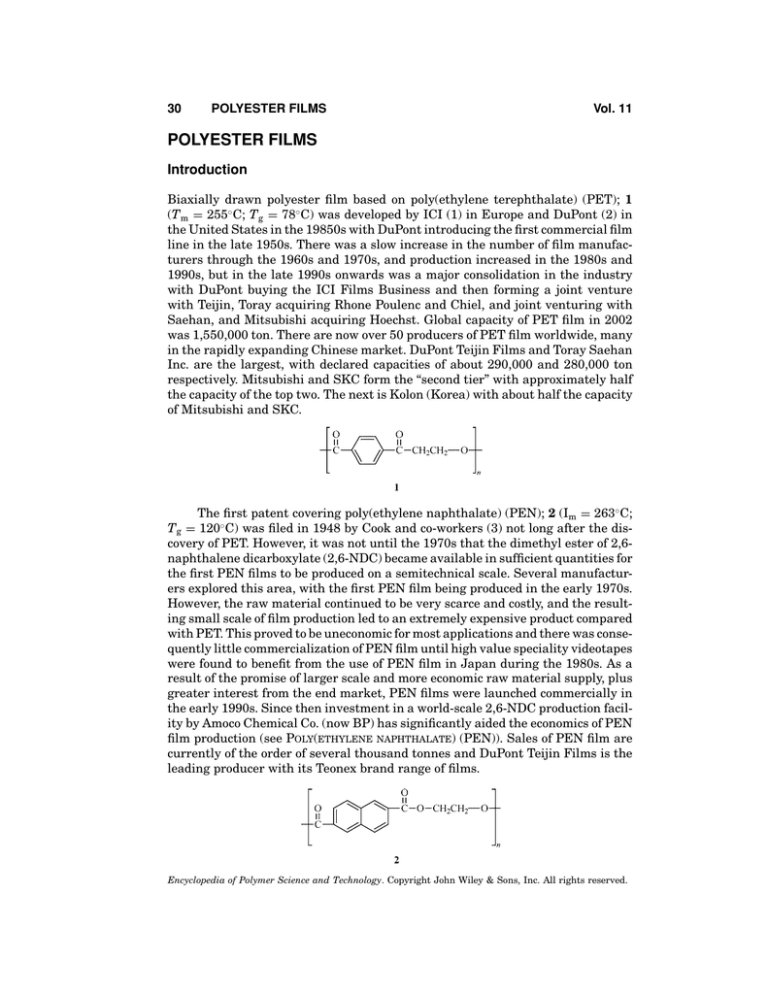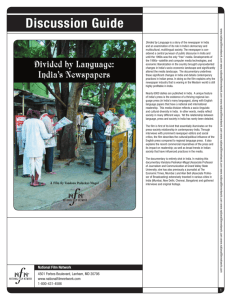
30
POLYESTER FILMS
Vol. 11
POLYESTER FILMS
Introduction
Biaxially drawn polyester film based on poly(ethylene terephthalate) (PET); 1
(T m = 255◦ C; T g = 78◦ C) was developed by ICI (1) in Europe and DuPont (2) in
the United States in the 19850s with DuPont introducing the first commercial film
line in the late 1950s. There was a slow increase in the number of film manufacturers through the 1960s and 1970s, and production increased in the 1980s and
1990s, but in the late 1990s onwards was a major consolidation in the industry
with DuPont buying the ICI Films Business and then forming a joint venture
with Teijin, Toray acquiring Rhone Poulenc and Chiel, and joint venturing with
Saehan, and Mitsubishi acquiring Hoechst. Global capacity of PET film in 2002
was 1,550,000 ton. There are now over 50 producers of PET film worldwide, many
in the rapidly expanding Chinese market. DuPont Teijin Films and Toray Saehan
Inc. are the largest, with declared capacities of about 290,000 and 280,000 ton
respectively. Mitsubishi and SKC form the “second tier” with approximately half
the capacity of the top two. The next is Kolon (Korea) with about half the capacity
of Mitsubishi and SKC.
The first patent covering poly(ethylene naphthalate) (PEN); 2 (Im = 263◦ C;
T g = 120◦ C) was filed in 1948 by Cook and co-workers (3) not long after the discovery of PET. However, it was not until the 1970s that the dimethyl ester of 2,6naphthalene dicarboxylate (2,6-NDC) became available in sufficient quantities for
the first PEN films to be produced on a semitechnical scale. Several manufacturers explored this area, with the first PEN film being produced in the early 1970s.
However, the raw material continued to be very scarce and costly, and the resulting small scale of film production led to an extremely expensive product compared
with PET. This proved to be uneconomic for most applications and there was consequently little commercialization of PEN film until high value speciality videotapes
were found to benefit from the use of PEN film in Japan during the 1980s. As a
result of the promise of larger scale and more economic raw material supply, plus
greater interest from the end market, PEN films were launched commercially in
the early 1990s. Since then investment in a world-scale 2,6-NDC production facility by Amoco Chemical Co. (now BP) has significantly aided the economics of PEN
film production (see POLY(ETHYLENE NAPHTHALATE) (PEN)). Sales of PEN film are
currently of the order of several thousand tonnes and DuPont Teijin Films is the
leading producer with its Teonex brand range of films.
Encyclopedia of Polymer Science and Technology. Copyright John Wiley & Sons, Inc. All rights reserved.
Vol. 11
POLYESTER FILMS
31
Fig. 1. A Typical film manufacturing process.
The Film Process
Biaxially oriented PET and PEN films are exclusively produced by a stenter process where commonly the amorphous cast film is drawn in the machine direction (MD) by passing it over heated rollers and then fed into a stenter frame
to achieve a draw in the transverse direction (TD) (see FILMS, MANUFACTURE;
FILMS, ORIENTATION). A schematic of the process is shown in Figure 1.
Normally the sequence of steps is as described above (MD–TD), but the process can be reversed (TD–MD) (4–6); and even a simultaneous stenter process (7)
whereby the clips are not interconnected and stretching can therefore be carried
out by accelerating the clips in the MD within the diverging TD draw section, has
been commercialized. Using this basic process film with thicknesses from 0.6 to
350 µm can be prepared.
The conversion of polymer into film falls into four basic stages:
(1)
(2)
(3)
(4)
Polymer preparation and Handling
Extrusion and casting
Drawing and heat setting
Slitting, Winding, and Recovery
The film process and in particular the morphology developed during processing has been described in more detail elsewhere (8,9).
Polymer Preparation and Handling. Polymer can be extruder-fed to the
drawing process or it can be directly fed from a continuous polymerizer (CP), but in
both cases the virgin polymer tends to be of a number-average molecular weight
of about 20,000 although higher and lower molecular weights are filmed. With
the extruder-fed film lines the polymer handling involves blending and drying.
This is a consequence of the film process never being 100% material efficient and
virgin polymer is therefore blended with polymer reclaimed from the film process.
Drying is essential in closed (single-screw) extrusion systems as the polyesters are
susceptible to hydrolysis, resulting in a reduction in molecular weight, but less
commonly, processes have evolved based on vented (twin-screw) extruders where
32
POLYESTER FILMS
Vol. 11
moisture is removed just after melting. In the drying stage, polymer is crystallized
first to avoid the chip sintering during drying and then dried for several hours
at 160–180◦ C to reduce the moisture level to 10–30 ppm. Close-coupled CP film
lines do not have this stage and melt is pumped directly through filtration to
the die.
Extrusion and Casting. The blended and dried polymer is next meltextruded through a slot die. There is usually melt filtration before the die to
remove degraded polymer, gels, catalyst residues, and pipe deposits. The extrusion system is typically designed to deliver stable output up to about 2.6 ton/h
over a wide range of operating conditions and throughputs. Exceptionally, higher
outputs are possible, up to about 3.5 ton/h on thick film lines, using complex tandem or parallel extrusion systems (10). More recently twin-screw extruders have
been introduced on some film lines to widen the operating window and to provide
capital-efficient high throughputs. These are able to cope with a wider range of
molecular weights, improve the mixing, and have the advantage of extruding at
lower melt temperatures. Other combinations such as tandem single screws with
melt pumps are also used to give a stable output. Parallel extrusion systems are
also commonly used for high output but these present the problem of ensuring
homogeneous melt stream blending. Whichever extrusion system is employed, its
purpose is to transport a consistent flow of polymer melt to the flat film die of a
stenter process.
The die which can be center- or end-fed converts the melt from a circular cross
section to a uniformly thick melt curtain of the required width. The thickness of
the film is continuously measured across the web after the stenter process, giving
a thickness or gauge profile. This profile data is used to make fine adjustments to
flow profile at the die either through thermoviscous heating or by actuation of mechanical bolts (which physically modulate the die gap profile to achieve uniform
film thickness profile). Combinations of thermoviscous and mechanical modulation are also employed in some cases.
The purpose of the casting is to produce a continuous uniformly thick film of
noncrystalline polymer with no surface blemishes and this is achieved by drawing
down the melt curtain onto a casting drum. The polymer melt from the extrusion
system will normally be between 280 and 310◦ C so as to minimize crystallization,
which would increase film haze and brittleness and possibly cause a film breakage
later in the filming process (9). To ensure this the molten film is cooled as quickly as
possible below its glass-transition temperature by cooling the casting drum using
recirculated water which passes through a heat exchanger to control its temperature between typically 10 and 15◦ C. Thin film can be satisfactorily cooled using a
single drum, normally of size 600–900 mm in diameter, but for thicker films where
the insulating properties of the film prevent cooling through to the air (nondrum)
contacting side of the melt, a second drum is used to provide additional cooling.
As the casting drum rotates, air is drawn into the gap between the film of
melt and the drum, affecting the contact of the two surfaces and the effectiveness
of the cooling. This is avoided by electrostatically charging the film surface by
using a pinning wire or blade electrode stretched across the drum just below the
die face (11–13). This creates an electrostatic field around the wire or blade which
induces a charge on the melt curtain surface. Since the drum is earthed the charge
forces the melt curtain onto its surface.
Vol. 11
POLYESTER FILMS
33
The surface of the casting drum must be of a very high standard so as to
avoid imprinting any patterning or “graininess” onto the cast film. The surface
must also be hard in order to avoid damage and be resistant to corrosion so that
no pitting occurs. Therefore a drum that is hard chrome plated and highly polished
is usually favored. During operation the casting drum must be free of vibration
and rotate smoothly so as to minimize any source of variation in thickness in the
MD of the film.
Drawing and Heat Setting. The cast film initially passes through a preheat zone, where the temperature of the cast film is raised by passage over a series
of heated contact rolls until a point, usually about 15◦ C above its glass transition,
T g , where the material can be readily stretched.
The forward draw stage physically stretches the heated polyester film between two nip roll systems with a surface speed differential and is designed to
improve its tensile properties in the MD. Stretch ratios of around 3.5:1 are employed, and the stresses in the structure caused by this step align the molecular
chain segments in the direction of the stress and thereby raise its tensile modulus
and strength by a factor of about 3.
In the second stage of the stenter oven, the edges of the film web are clipped
and led along diverging rails that cause the material to be stretched at temperatures above 100◦ C (135◦ C for PEN), for the second occasion, by a factor of between
3 and 4. The object of this step, the sideways draw, is to develop the properties of
the film in the TD via orientation at the molecular level, to a point where they
balance or approximately balance those measured in the MD (9). The process
tends to align molecular chain segments not already aligned in the MD and to
realign some MD-oriented crystallites toward the TD. The film at this stage is
anisotropic.
The final stage in the stenter oven is designed to develop a crystalline morphology in the film which retains the improved mechanical properties from the
drawing stages and which is more stable over time and at elevated temperature.
The heat set or crystallization stage of the process comprises three or more
regions of the stenter oven, each with independent temperature control and the
capability to adjust the lateral dimension of the web. Thus film can be treated to
a range of thermal and strain programs to optimize its final properties. Temperatures of the film can exceed 230◦ C and although residence time may be only a
few seconds this is sufficient for density changes equivalent to a rise of 30–40%
in crystallinity to occur. On the same timescale, the noncrystalline regions of the
film can exhibit significant molecular relaxation.
Unless all physical anisotropy can be removed from the noncrystalline fraction of biaxial PET film, the product will undergo residual shrinkage at elevated
temperature. By managing both the film temperature and a relaxation of strain,
achieved by a small convergence of the stenter rails (known as toe-in) during the
heat set stage, it is possible to achieve considerable control of this film property (9).
Slitting, Winding, and Recovery. The film in and close to the clips is very
thick and cannot be wound into film. This is slit off as the film exits the stenter
and reclaimed for reprocessing into film. It is combined with scrap film and is
either cut up into flake and compacted into particulate form or is reextruded and
formed into pellets. This reclaimed polymer either is fed back in with the virgin
polymer at the start of the film process or is fed into the CP process.
34
POLYESTER FILMS
Vol. 11
The edge trimmed film is then wound up. Rolls of film can be produced either
on the stenter, or alternatively they can be slit down off line to the width and
lengths required.
Surface and Bulk Properties Control
Film Properties. The film process described produces rolls of PET and
PEN films that have the properties required for a standard PET or PEN film,
ie high mechanical strength, good flexibility, excellent visual properties, flat and
dimensionally stable, and available in a range of thicknesses. The difference in
chemical structures of PET and PEN is shown by 1 and 2. The substitution of
the phenyl ring of PET by the naphthalene double ring of PEN has very little
effect on the melting point (T m ), which increases by only a few degree Celsius.
However, there is a significant effect on the glass-transition temperature (T g ),
which increases from 78◦ C for PET to 120◦ C for PEN. The result of this is that
although the good thermal properties of PET and PEN films enable them to retain
physical, chemical, and electrical properties over a wide temperature range, PEN
has significantly improved thermal resistance relative to PET. This is particularly
noticeable with regard to PEN’s higher continuous use temperature (14) Table 1.
The typical properties listed in Tables 1–5 are from DuPont Teijin Films
Teonex PEN film datasheet and are for illustrative purposes only and are not
intended to be used as design data.
Table 1. Thermal Properties of PET and PEN
Sample thickness, µm
Teonex® PEN film PET film standard
Q51-25 µm
Grad-25 µm
Test method
Melting point, ◦ C
Glass-transition temperature, ◦ C
Shrinkage (150◦ C, 30 min), %
MD
269
121
—
—
258
78
—
—
DSC
0.4
—
1.5
—
JIS C-2318
(modified
to TDF)
TD
Shrinkage (200◦ C, 10 min), %
MD
TD
Coefficient of thermal expansion
(10 − 6 /RH%), –
MD
Coefficient of hydrolic expansion
(10 − 6 /RH%), –
MD
Continuous use temperature, ◦ C
Mechanical
Electrical
0.0
—
0.2
—
2.0
1.0
—
—
4.0
1.5
—
—
Ditto
13
—
15
—
TDF method
11
—
11
—
Ditto
160 (≥25)
180 (≥25)
—
—
105 (all)
105 (all)
—
—
UL 746B
Vol. 11
POLYESTER FILMS
35
Table 2. Mechanical Properties of PET and PEN
Property
◦
Typical values
Test method
200
3,900
130
105
1,395
100,000
ASTM D882-80
ASTM D882-80
ASTM D882-80
ASTM D882-80
ASTM D1505-66
ASTM D2176-63
294
7.4
0.33
1.64
1.0 × 10 − 5
ASTM D1004-66
ASTM D1922-67
ASTM D1003-61
ASTM D-542-50
a
Tensile strength (MD) at 25 C, MPa
Tensile modulus (MD) at 25◦ C, MPaa
Elongation (MD) at 25◦ C, %
Stress to produce 5% elongation (MD) at 25◦ C, MPaa
Density at 25◦ C, g/cm3
Folding endurance 1 kg loading, 25◦ C, cycles
Tear strength, N/mm
Initial (Graves) 25◦ C
Propagating (Elmendorf) 25◦ C
Coefficient of friction (kinetic) at 25◦ C
Refractive index (AB 8E at 25◦ C), ND25
Coefficient of hygroscopic expansion, Mm/mm (%RH)
a To
convert MPa to psi, multiply by 145.
Table 3. Barrier Properties of PET and PEN
Sample thickness, µm
Water vapor permeability,
g/(m2 · 24 hr)
Gas permeability CO2 ,
cm3 /(m2 · 24 h · atm)
Gas permeability O2 ,
cm3 /(m2 · 24 h · atm)
Breakdown voltage,
KV/mm
Teonex® PEN film
Q51-25 µm
PET film standard
Grad-25 µm
Test method
6.7
—
21.3
—
JIS-Z0208
97
—
328
—
ASTM
D1434-82
21
—
55
—
300
280
JIS C-2318
Table 4. Electrical Properties of PET and PEN
Sample thickness, µm
Teonex® PEN film
Q51-25 µm
PET film standard
Grad-25 µm
3.0
2.9
2.9
3.2
3.1
3.0
JIS C-2318
0.003
0.005
0.005
2
0.002
0.006
0.008
6
JIS C-2318
JIS C-2151
10
7
JIS C-2318
0
82
Test method
◦
Permittivity (25 C)
60 Hz
1 kHz
1 GHz
Dissipation factor (25◦ C)
60 Hz
1 kHz
1 GHz
Surface resistivity (25◦ C),
1017 Volume resistivity (25◦ C),
1017 · cm
UV light permeability at 360
nm, %
TDF method
36
POLYESTER FILMS
Vol. 11
Table 5. PET and PEN Films—Comparative Informationa
Amorphous
Crystalline
Properties
PES
PC
PEN
PET
OPP
PPS
Tg , ◦ C
Tm , ◦ C
Young’s modulus, GPab
Tensile strength, MPac
223
150
2.2
83
1.7
60
121
263
6.1
275
78
255
5.3
225
−10
170
2.4
250
90
285
6.72
225
a Data in this table are gleaned from different datasheets on different thickness films. Data are for
comparison between the films only and the numbers should not be taken as absolute.
b To convert GPa to psi, multiply by 145,000
c To convert MPa to psi, multiply by 145.
PET and PEN retain their physical properties, including tensile strength,
Young’s modulus, and tear strength over a wide temperature range (−70 to 150◦ C)
(14) (Table 2). PEN is generally a stiffer film than PET for a given thickness. This
has been exploited in the development of the advanced photo system for consumer
imaging where it has been possible to downgauge the film, resulting in a smaller,
thinner reel of photographic film.
The chemical properties of PET and PEN films include excellent resistance
to most chemicals. They retain 100% of tensile strength and modulus after 31 days
at 23◦ C in glacial acetic acid, 10% hydrochloric acid, 10% nitric acid, 30% sulfuric acid, 2% sodium hydroxide, 2% ammonium hydroxide, benzyl alcohol, dioxane(1,4), ethyl acetate, ethyl alcohol, methyl ethyl ketone, toluene, trichloroethylene, tetrahydrofuran, cyclohexane, sulfurhexafluoride, 28% hydrogen peroxide,
dimethyl formamide, tricresyl phosphate, and 0.25% detergent. PET film is dissolved by hexafluoro-2-propanol, m-cresol, o-chlorophenol and is attacked by 35%
nitric acid, 10% ammonium hydroxide, and n-propylamine (14). PET and PEN
films also have very low moisture permeability and overall resistance to staining
by various chemicals and food products. PEN film has superior barrier properties
relative to PET film (Table 3), and the gas and vapor barrier properties can be
significantly improved by coating with a barrier coating such as poly(vinylidene
chloride) or by vacuum metallization (15) (see BARRIER POLYMERS).
PET and PEN films have excellent electrical insulating properties as shown
in Table 4 (14).
Because of their excellent thermal, insulating, and moisture-resistant properties, they are used in a wide variety of electrical applications, with PEN being
the preferred candidate in applications that require higher temperatures and good
hydrolysis resistance.
However, for many of the specialty applications that PET and PEN films are
used in, further modification of either the surface or bulk properties are required
as illustrated below.
Coating. PET and PEN are fairly inert polymers and for many applications the surface of the film is altered by coating or adhesive lamination to other
materials, eg film for packaging will be lacquered to accept inks or adhesives, or,
for photographic applications, primed to accept photosensitive overcoats. Coatings
are also applied to achieve other surface effects, such as antistatic, barrier (water,
oxygen, carbon dioxide, flavor), release, and frictional characteristics (8,9).
Vol. 11
POLYESTER FILMS
37
These coatings are usually acrylic-, vinyl-, polyester-, or polyurethanebased, and PET and PEN films are commonly coated either “in-line” or “off-line”.
“In-line” coating usually involves aqueous-based materials, and is carried out between the forward draw and before entering the stenter, while “off-line” coating
involves unwinding and priming the surface of preformed film reels with aqueousor solvent-based coatings. In both cases, the coating may be applied to one or
both sides, and some products have different coatings applied to either sides
of the film. Coatings are mostly applied by offset gravure or by direct gravure
coating.
Coextrusion. Coextrusion (qv) is used to produce a film with two or more
different polymer layers, so that one or both surfaces of the film have different
properties to the “core” polymer. In addition, coextrusion allows manufacture of
products with layers thinner than can be made and handled as individual layers.
Coextrusion provides a means of flexibly configuring a wide range of film laminate
structures which cost-effectively meet product requirements.
The basic coextrusion process consists of the generation of two or more melt
streams and their confluence while in the melt phase. The number of separate
extrusion systems is determined by the number of polymer types. This is typically
2, but occasionally 3 and exceptionally up to 10. Each polymer type to be incorporated in the structure is separately melted, pressurized, and (optionally) filtered
in parallel extrusion systems before flowing into the coextrusion hardware. The
optimum method of bringing the separate melts together depends primarily on
their respective flow behaviors. The melt layers must remain distinct but well
bonded in the process from the point(s) of confluence through to solidification.
There are basically two hardware configurations in use for common polymers:
the multi-manifold die and the injector block. Combinations of the two are also
possible for complex structures (8,9).
Fillers. Fillers (qv) are added to PET for two main reasons: either to modify
surface properties, or to modify bulk properties. Particulate fillers such as clays
and silica, typically a few micrometers in diameter, are added to create surface
roughness during the film drawing process. A primary function of the surface
roughness is to reduce the blocking or sticking propensity of the otherwise very
smooth film surfaces during winding and reel formation. The roughness also enhances dynamic handling behaviour particularly for high speed transport and
winding of thin films through subsequent conversion processes. Surface optical
properties can also be regulated via filler-induced surface roughness, for example,
to control gloss or eliminate Newton’s ring fringes between adjacent film layers (9).
Although mechanical properties such as softness, stiffness, and toughness
can be addressed, it is most common for optical properties to be modified via
particles. Opacity and whiteness are generated by two discrete mechanisms. Simple pigmentation (light scattering from the particle–polymer interface) can be
achieved using similar titanium dioxide technology to that employed in the fibers
and coatings industries. It is, however, more common for the anatase crystal form
to be employed since this is a less abrasive pigment than the more strongly scattering rutile. The second mechanism involves using the additive to generate microvoiding during the film draw. The additive can be inorganic, for example barium sulfate or calcium carbonate, or polymeric, for example, polypropylene. In this
mechanism the opacity is derived from scattering between the polymer and the
38
POLYESTER FILMS
Vol. 11
void. The use of microvoiding confers the potential advantage of a softer film of
reduced density.
Shrinkage. Standard PET and PEN films from the stenter process will
shrink between 1 and 3% at temperatures above the T g . For the high level of
accuracy required by some electrical applications shrinkages of below 0.1–0.2%
are required. In order to meet this the film is unwound and passed through a
carefully temperature-controlled oven, with almost no tension in the film. The
amount of residual shrinkage in the film after this process is typically less than
0.1% in the MD and the TD for temperatures up to 150◦ C for PET and 200◦ C for
PEN.
General Comments on Comparison with Other Films. It is not possible in this article to give a detailed comparison of polyester films compared to other
films as each class of film has different strengths and weaknesses and serve different markets. Both PET and PEN films are biaxially oriented crystalline films; this
imparts unique properties and differentiates them from amorphous films such as
polycarbonate (PC) and polyethersulfone (PES) films. As a generalization PET and
PEN films are stiffer films compared to amorphous films (Table 5); they have very
good solvent resistance and low moisture absorption, but PES film in particular
is a higher T g and higher temperature performance film and PC film has superior clarity. Compared to crystalline films such as oriented polypropylene (OPP),
PET and PEN films are higher temperature performance films. Polyphenylene
sulfide (PPS) film is a high performance biaxially oriented crystalline film and
has a similar continuous use temperature, but a lower T g compared to PEN film.
PEN has better dimensional stability but PPS offers superior flame retardancy
and chemical resistance.
The particular strength of polyester films, however, is the wide range of film
effects that can be achieved with fillers, coatings, coextrusion, etc, as outlined in
the previous sections—this versatility is unique in the films market.
Application. Typical application areas that exploit the properties of
polyester film are illustrated in Table 6. It can be seen that usually a combination of properties are required and these are achieved by a combination of base
film properties, fillers, coatings, and coextrusion technologies.
Future Trends
The unique blend of properties of PET and PEN films makes them extremely
versatile products and the growth in the films market is predicted to be above 5%
per annum. However this masks that some areas such as packaging, industrial,
and electrical applications are growing at a greater rate whereas the growth in
the more traditional markets such as magnetic media or graphic arts materials is
more modest. Advances are continually being made in uprating the film process,
but in addition new applications for PET and PEN are continually being developed.
The trend will be increasingly toward differentiation through the application of
new process technologies and advances in the control of the process coupled with
the combinations of base polymer, filler, coating, and coextrusion technologies.
Vol. 11
POLYESTER FILMS
39
Table 6. Examples of Typical Film Applications and the Key Properties Required
Application
Packaging
Labels
Imaging
• Montage
• Microfilm
• Digital technology media
• APS (PEN)
Casting and release
Capacitors
Electronics
• Flexible printed circuits, flat
flexible cable
• Membrane touch switch
• Loudspeakers
• RFID tags
• Automotive wiring (PEN)
Coil coating/fiber-reinforced
plastics
Electrical insulation
• Motors
• Cable
Magnetic media
• Floppy disks
Film properties required
Seal (peelable through to permanent)
Wide heat seal range
Barrier (oxygen and aroma)
White, clear
Surface roughness
Pretreats to allow metal, ink, sealant adhesion
Stiffness
12–30 µm
Clear, white, matte, black
Durability
Adhesion with inks
Silicone adhesion
23–175 µm
High opacity, white through to high clarity, flatness,
Antistat
Dimensional stability
Adhesion with inks
50–175 µm
Stiffness
Wider range of surface textures from high gloss
to very matte
Release coats
12–50 µm
Thin film
Low shrinkage
Electrical–thermomechanical properties
0.9–23 µm
Brilliant clarity-white film
Electrical properties
Low shrinkage
Durability
Adhesion with inks
12–175 µm
High temperature performance
Hydrolysis resistance
Heat bondable
UV stable
12–125 µm
High dielectric strength
Thermal endurance at elevated temperatures
Dimensional stability
Durability
Chemical resistance
12–350 µm
Tensilized film
Surface quality
40
POLYESTER FILMS
Vol. 11
Table 6. (continued)
Application
• Video
• High density storage (PEN)
Medical test strip
Electronic displays (PEN)
Cards
Film properties required
Dimensional stability
Sublayer for magnetic coating
Stiffness
Dimensionally stable
High stiffness
Inert and plasticizer free
Adhesion with ink
Hydrophilic surface
Clear (matte or glossy), white (high opacity or
translucent)
High temperature stability
Dimensional stability
Clarity
Surface quality
Durability
Adhesion with inks
Heat bondable
Temperature resistance
100–350 µm
BIBLIOGRAPHY
1.
2.
3.
4.
5.
6.
7.
8.
9.
10.
11.
12.
13.
14.
15.
Br. Pat. 609,797 (1948), J. C. Swallow and D. K. Baird (to ICI).
U.S. Pat. 2,823,421 (1958), A. C. Scarlett (to E. I. du Pont de Nemours & Co., Inc.).
Br. Pat. 604,073 (1948), J. G. Cook, H. P. W. Huggill, and A. R. Lowe (to ICI).
U.S. Pat. 3,256,379 (1966), C. J. Heffelfinger (to E. I. du Pont de Nemours & Co., Inc.).
Fr. Pat. 2,529,506A1 (1984), M. Jacquier and J. Barbey (to Rhone Poulenc).
Eur Pat. 0,0971,08A1 (1983), M. Jacquier (to Rhone Poulenc).
Eur Pat. 008,693 (1979), M. Motegi, I. Kimata, and S. Fujita (to Toray).
H. F. Mark, ed., Encyclopedia of Polymer Science and Engineering, 2nd ed., Vol. 12,
John Wiley & Sons, Inc., New York, p. 193, and references contained therein.
W. A. MacDonald and D. H. Mackerron, in D. W. Brookes and G. A. Giles, eds., PET
Packaging Technology, Sheffield Academic Press, 2002, pp. 116–157, and references
contained therein.
F. Hensen and H. Bongaerts, Plastverarbeiter 30, 618, (1979)
U.S. Pat. RE 26,951 (1970), A. Vaccaro (to Celanese).
U.S. Pat. 3,223,757 (1965), J. Owens and W. Vieth (to E. I. du Pont de Nemours & Co.,
Inc.).
U.S. Pat. 4,309,368 (1982), D. Groves (to ICI).
Melinex® PET Film data sheet, DuPont Teijin Films, Luxembourg
(http://www.dupontteijinfilms.com).
Teonex®
PEN
Film
datasheet,
DuPont
Teijin
Films,
Luxembourg
(http://www.dupontteijinfilms.com).
W. A. MACDONALD
DuPont Teijin Films UK Limited
Vol. 11
POLYESTERS, FIBERS.
POLYESTERS, UNSATURATED
See Volume 3.
POLYESTERS, THERMOPLASTIC.
See Volume 7.
41







